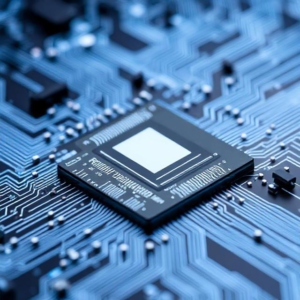What is an FPGA (Field-Programmable Gate Array)?
An FPGA is a type of chip that can be programmed or reconfigured to perform different tasks. It’s kind of like a “blank slate” that can be customized by the user to do specific jobs. You can think of it as a flexible, reprogrammable piece of hardware.
- Programmable: You can change what the FPGA does even after it’s been made. It’s like you can write new software for it, but in hardware terms.
- Reconfigurable: If you want to change how the FPGA works later, you can just reprogram it. This is useful for testing new ideas or making adjustments to your design.
Pros of FPGAs:
- Flexibility: You can reprogram it as many times as you want, so it’s great for prototyping and experimentation.
- Faster Development: Since you can make changes quickly, it’s good for situations where you need to develop something quickly or make tweaks.
- Lower Upfront Cost: It’s cheaper to get started with an FPGA, especially for small projects or low-volume production.
Cons of FPGAs:
- Slower than ASICs: Since it’s flexible and programmable, it’s usually slower and less efficient than an ASIC that’s built for one specific purpose.
- Power Consumption: FPGAs tend to use more power compared to ASICs because they have general-purpose logic that isn’t optimized for specific tasks.

What is an ASIC (Application-Specific Integrated Circuit)?
An ASIC is a custom-designed chip built for a specific task. Unlike FPGAs, once an ASIC is made, it can’t be reprogrammed or changed. It’s like designing a custom-built tool for a particular job.
- Specialized: ASICs are designed to perform a very specific function and nothing else. For example, an ASIC might be made to handle a particular type of encryption or run a specific algorithm.
- Fixed: Once the ASIC is built, it’s locked in and can’t be changed. This is great for mass production where you need high performance and efficiency for that one specific task.
Pros of ASICs:
- Very Fast: ASICs are highly optimized for the task they’re designed for, so they perform much faster than FPGAs.
- Power Efficient: Since the ASIC is built for a specific job, it consumes less power compared to an FPGA, which is more general-purpose.
- Small and Compact: ASICs can be designed to be very small and efficient for the task they do.
Cons of ASICs:
- Expensive to Develop: Designing an ASIC can be very expensive and time-consuming, especially because the process can’t be changed once it’s made.
- No Flexibility: Once the ASIC is built, you can’t modify it. If you want to change its functionality, you need to design a new ASIC.
- Longer Time to Market: It takes longer to design and manufacture an ASIC compared to programming an FPGA.
FPGA vs ASIC: Key Differences
| Feature | FPGA | ASIC |
|---|---|---|
| Flexibility | High (can be reprogrammed) | Low (custom-designed for a specific task) |
| Performance | Slower (more general-purpose) | Faster (optimized for one task) |
| Power Efficiency | Less efficient (uses more power) | More efficient (uses less power) |
| Development Cost | Lower (cheaper to start) | High (expensive to design) |
| Time to Market | Shorter (can be developed quickly) | Longer (takes time to design and build) |
| Best Use Case | Prototyping, testing, small-volume applications | High-volume, specific applications needing performance and efficiency |
When to Use an FPGA?
- When you need to quickly prototype or test your design.
- If your design might change over time or if you want flexibility.
- For low-to-medium-volume production where you don’t want to invest in expensive ASIC development.
When to Use an ASIC?
- If you’re working on a high-volume product that requires optimal performance and low power usage.
- If you have a very specific application that doesn’t need to change over time.
- When you can afford the upfront cost of development and want the most efficient solution for mass production.
Summary:
- FPGA: Flexible, programmable chips that are great for testing and experimentation, but not as fast or power-efficient as ASICs.
- ASIC: Custom-built chips for one specific task, offering high performance and low power consumption but with high development costs and no flexibility once made.











